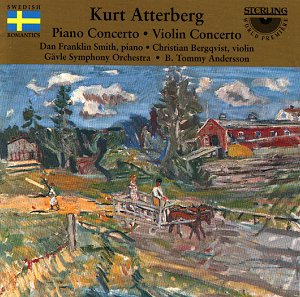
This CD is definitely 'hot off the presses' having not yet been announced
at the time of writing (4 October 1999). I am grateful to Bo Hyttner (Sterling's
guiding light) for allowing me what seems to have been an advance copy. Look
also at how recently the recording sessions took place!
Atterberg's Scandinavian romantic music has benefited from the collective
effort (probably uncoordinated) of a variety of labels. The symphonies are
now all in the bag apart from Symphony No. 9 and (like Malcolm Arnold) a
Symphony for Strings. Outstanding and presumably to come in due course would
be recordings of the double concerto, the extremely fine three interludes
from the Arabian Nights opera, Fanal and the tone poem The River (nothing
to do with Palmgren's similarly titled second piano concerto).
The piano sets a commanding presence in the concerto from the very beginning.
This work positively radiates glinting muscularity of a decidedly Rachmaninovian
caste. The parallel works, stylistically speaking, are the concertos by Arensky,
Scriabin (very strong resemblances) and Rachmaninov 1 and 4. The American
pianist has given this piece in concert and his seeming confidence and command
are patent in the cascading fury of the first movement. The recording's healthy
spatial qualities suggest a massive expanse of hall and a wide-span for the
orchestra. There is some mordant work for the horns and at 7.30 ice cavern
imagery. The andante lopes and swoons along in a Griegian Gothic trance though
once or twice I couldn't help thinking about Nights in the Gardens of Spain.
The tunes here are of a warm pulsing succulence and a satisfyingly dewy
melancholy. The finale misses the level of inspiration of the first two movements
but not by much. There is a slightly Coatesian character to the galumphing
theme. Smith's shaping of the theme at 3.03 is accomplished with utmost
sensitivity. Smith is not a barnstormer by nature though when required he
can storm barns with the best. A concerto which all lovers of the late-romantic
era must hear.
The Violin Concerto is in three movements with a tautly spun web of string
tremolandi providing a bed over which the violin sings the main theme with
husky concentration and then with warm sweetness (2.48). There are many
persuasive and subtle coups in the orchestra (the Gävle orchestra is
most impressive) like the gentle pizzicato notes at 9.55. In the central
movement Atterberg skilfully and yet spontaneously treads the line between
sentiment and sentimentality. Here the violin is the sweet singer of songs
- a partner to the Finzi Introit. The horn contributions in the finale are
thick with hoar frost and an icy-blast cuts through the textures. Atterberg's
ideas seem to flow like wine and in flooding abundance - coup follows imaginative
coup. He tops things off by ending the concerto with a valorously audacious
ppp floating close to the doe-eyed trance of Rimsky's Sheherazade.
With typical self-effacement Mr Hyttner makes no reference to the fact that
these are recording premieres. They have been known, if at all, to those
fortunate enough to have heard off-air tapes. Jacob Moscowicz (whose Sterling
CD of the Piano Concerto by Natanael Berg I hope to review soon) broadcast
the piano concerto over Swedish Radio with the Stockholm PO conducted by
Sten Frykberg. Helga Hussels gave us the violin concerto in a radio studio
tape with the Goteborg SO and Erich Schmid. Both performances are full of
character but in the hands of Smith and Bergkvist we have eloquently persuasive
versions to treasure and enjoy.
Production values in Sterling discs are always high. Note the number of days
given over to the recording sessions for these works. This is a major cultural
achievement for all concerned and tribute should be paid to the enlightened
policy of the Swedish National Council for Cultural Affairs. Would that such
spirit were to be found in the UK!
These are deeply enjoyable works of lively mastery. Anyone who has been
collecting the Hyperion romantic piano concerto series must not miss them.
The Sterling discs in their splendid gold livery (and in the case of both
this disc and the Atterberg 7 and 8 featuring paintings by Eric Hallström)
are eminently collectible. This is a label (rather like the Lyrita and Hyperion
labels) that consistently achieves excellence in all aspects. Each issue
is looked forward to with eager anticipation. It is our loss that our
major-dominated media seem too often to overlook Sterling's delights. Do
explore Atterberg and what better place to start than these two starry concertos.
Reviewer
Rob Barnett

